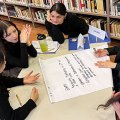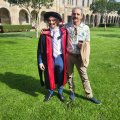UQ undergraduate Sean Murphy has experienced first-hand how exciting scientific discoveries are often made by accident.
Mr Murphy helped discover what is now known as the “Flashed Face Distortion Effect” while working alone in a lab on a set of facial images for a different experiment.
A short video demonstrating the phenomenon has since attracted more than three million hits on YouTube in just two weeks.
The breakthrough came when Mr Murphy aligned a set of faces at eye-level and skimmed through them. After a few seconds, he noticed that some of the faces began to appear deformed and grotesque.
He then looked at the affected faces individually to find nothing looked out of the ordinary. It was then that he brought his findings to the attention of UQ PhD candidate Matthew Thompson and School of Psychology Lecturer Jason Tangen, who wanted to share his discovery with the world via YouTube.
Mr Murphy explained the effect seemed to depend on processing each face in light of the others.
“The Flashed Face Distortion Effect occurs when people view, in quick succession, a bunch of normal face photographs that are positioned on top of one another; the faces then start to look horribly grotesque,” he said.
“If someone has a large jaw normally, it now looks almost ogre-like. If they have an especially large forehead, then it looks particularly bulbous, but if you pause the video, blink a few times, and then look at the faces, they look completely normal.
“By aligning the faces at the eyes and presenting them quickly, it becomes much easier to compare them, so the differences between the faces are more extreme.”
Mr Murphy said it was gratifying to share his discovery with the world.
“I think it shows that people really are interested in science – just as long as you don’t call it that,” he said.
“Cool findings like this one are often buried in scientific journals so the public rarely get a chance to appreciate them.”
Mr Murphy and his co-authors now want to understand how people recognise and identify complex patterns, such as human faces, and are conducting experiments to figure out exactly what’s causing this effect.
“People have lots of experience with faces and process them effortlessly. In our lab, we can use effects like this one to help us understand how people perceive faces, for example, what makes someone attractive or easy to recognise?” he said
“When our perception of the world is distorted, as with this illusion, it can tell us more about how the human visual system works than when we’re seeing things as they really are.
“We’ve really only begun to scratch the surface in explaining why this strange effect occurs, and we’re keen to delve deeper.”
Media: Sean Murphy (0404718864, sean.murphy1@uqconnect.edu.au or Kristen Bastian (07 3346 9279, k.bastian@uq.edu.au)
.jpg)


.png?itok=xWvYRDbm)







